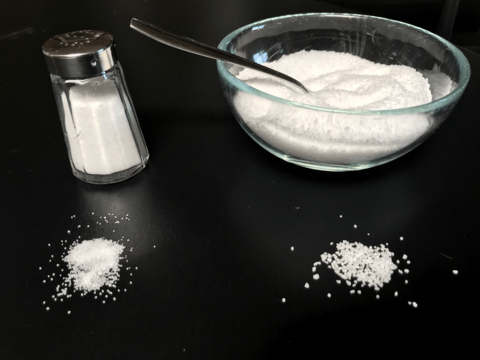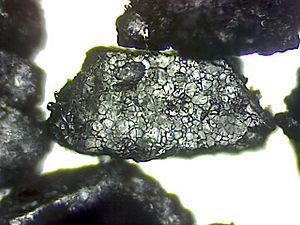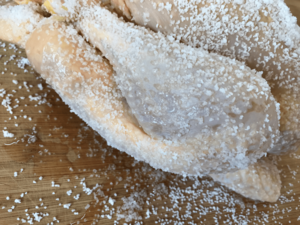Kosher salt facts for kids
Kosher salt is a type of salt often used in cooking. It's also known as kitchen salt or cooking salt. Unlike regular table salt, it usually has larger grains and doesn't contain common additives like iodine.
Kosher salt is mostly made of sodium chloride. Sometimes, it might have special ingredients called anticaking agents. These stop the salt from clumping together. People usually use kosher salt when they are cooking, not to sprinkle on food at the table.
Contents
Why is it Called Kosher Salt?
The name kosher salt became popular in North America. It comes from a Jewish religious practice. This practice is called kashering. It involves using salt to prepare meats. This helps remove blood from the meat. So, the name refers to how the salt is used, not that the salt itself is made in a special religious way. Some salt brands might say they are "kosher-certified." This means a religious group has checked and approved them.
How Kosher Salt is Used
Kosher salt is a favorite in many kitchens. Its unique qualities make it useful for different tasks.
Cooking with Kosher Salt
Many chefs prefer kosher salt for cooking. It doesn't have additives like iodine or fluoride. These can sometimes give other salts a slightly different taste. Kosher salt helps the natural flavors of your food shine.
Its larger grain size also makes it easier to use. When you sprinkle salt by hand, you can feel the grains better. This helps you guess how much salt you are adding.
Some recipes might ask for a certain amount of kosher salt by volume. But be careful! Different brands of kosher salt can have different densities. This means a cup of one brand might weigh less than a cup of another. So, if a recipe asks for salt by weight, it will be more accurate.
Using Kosher Salt for Brining Meat
Kosher salt is great for a process called dry brining. This makes meat more juicy and flavorful. It also helps meet some religious requirements for preparing meat.
Here's how it works:
- First, the meat is usually soaked in cool water.
- Then, it's drained and covered with a thin layer of kosher salt.
- The meat sits on a rack for an hour or more.
- The large salt grains stay on the meat's surface.
- They pull out liquids from the meat.
- These liquids are then partly reabsorbed, along with the salt. This helps to "brine" the meat in its own juices.
- Sometimes, people add herbs, spices, or sugar for extra flavor.
- Before cooking, the salt is rinsed off and thrown away.
Cleaning with Kosher Salt
Because of its coarse grains, kosher salt can also be used for cleaning. It works well as an abrasive cleaner for pots and pans. It's especially good for cast iron skillets.
If you mix it with oil, it stays abrasive. But after cleaning, you can easily wash it away with water. Other cleaners, like those made from pumice, can leave a gritty mess if not rinsed well. Kosher salt dissolves, leaving no residue behind.
How Kosher Salt is Made
Kosher salt crystals are not always shaped like perfect cubes. Some brands, like Morton Salt, make flat, plate-like crystals. Other brands, like Diamond Crystal, make hollow, pyramid-shaped crystals.
- The flat shape is often made by pressing cubic salt crystals between rollers.
- The pyramid shape is usually made using a special evaporation process. This is called the Alberger process.
Kosher salt grains are generally larger than regular table salt grains. Morton Salt comes from Chicago, IL, while Diamond Crystal salt is made by Cargill in St. Clair, MI.
See also
 In Spanish: Sal kosher para niños
In Spanish: Sal kosher para niños




